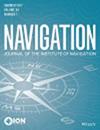Global Navigation Satellite System Channel Coding Structures for Rapid Signal Acquisition in Harsh Environmental Conditions
IF 2
3区 地球科学
Q1 ENGINEERING, AEROSPACE
引用次数: 0
Abstract
In this article, we present the design of a new navigation message system that includes an error-correcting scheme. This design exploits the “carousel” nature of the broadcast navigation message and facilitates (i) a reduction in the time to first fix (TTFF) and (ii) enhanced error-correcting performance under both favorable and challenging channel conditions. We show here that this combination design requires error-correcting schemes characterized by maxi - mum distance separable (MDS) and full diversity properties. Error-correcting Root low density parity check (Root-LDPC) codes operate efficiently to block various channels and thus can permit efficient and rapid recovery of infor - mation over potentially non-ergodic channels. Finally, to ensure appropriate data demodulation in harsh environmental conditions, we propose the use of Root-LDPC codes endowed with a nested property which will permit them to adjust the channel coding rate depending on the number of information blocks received. The proposed error-correcting combination design was then simulated and compared with the well-known GPS L1C subframe 2 using sev - eral different transmission scenarios. The results of these simulations revealed some enhancement of the error-correcting performance and reductions in TTFF in several specific situations.恶劣环境下快速信号采集的全球卫星导航系统信道编码结构
在本文中,我们提出了一个新的导航消息系统的设计,其中包括一个纠错方案。这种设计利用了广播导航信息的“旋转木马”特性,有助于(i)减少首次修复时间(TTFF)和(ii)增强在有利和不利信道条件下的纠错性能。我们在这里表明,这种组合设计需要具有最大距离可分离(MDS)和完全分集特性的纠错方案。纠错根低密度奇偶校验(Root- ldpc)码可以有效地阻塞各种信道,从而允许在潜在的非遍历信道上有效和快速地恢复信息。最后,为了确保在恶劣的环境条件下进行适当的数据解调,我们建议使用具有嵌套属性的Root-LDPC码,这将允许它们根据接收到的信息块的数量来调整信道编码速率。然后对所提出的纠错组合设计进行了仿真,并在几种不同的传输场景下与著名的GPS L1C子帧2进行了比较。这些模拟结果显示,在几种特定情况下,纠错性能有所增强,TTFF有所降低。
本文章由计算机程序翻译,如有差异,请以英文原文为准。
求助全文
约1分钟内获得全文
求助全文
来源期刊

Navigation-Journal of the Institute of Navigation
ENGINEERING, AEROSPACE-REMOTE SENSING
CiteScore
5.60
自引率
13.60%
发文量
31
期刊介绍:
NAVIGATION is a quarterly journal published by The Institute of Navigation. The journal publishes original, peer-reviewed articles on all areas related to the science, engineering and art of Positioning, Navigation and Timing (PNT) covering land (including indoor use), sea, air and space applications. PNT technologies of interest encompass navigation satellite systems (both global and regional), inertial navigation, electro-optical systems including LiDAR and imaging sensors, and radio-frequency ranging and timing systems, including those using signals of opportunity from communication systems and other non-traditional PNT sources. Articles about PNT algorithms and methods, such as for error characterization and mitigation, integrity analysis, PNT signal processing and multi-sensor integration, are welcome. The journal also accepts articles on non-traditional applications of PNT systems, including remote sensing of the Earth’s surface or atmosphere, as well as selected historical and survey articles.
 求助内容:
求助内容: 应助结果提醒方式:
应助结果提醒方式:


